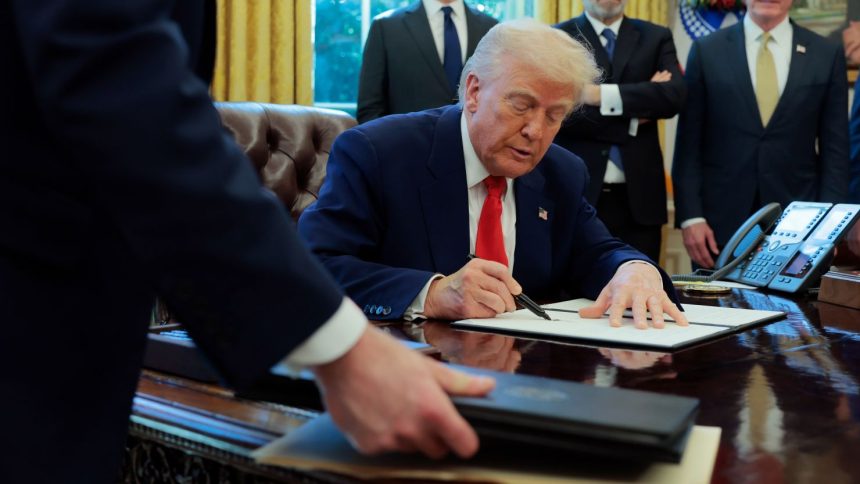CNN
—
President Donald Trump has repeatedly touted what he calls the return of manufacturing to the United States, hailing companies that have vowed to pour large amounts of money into making everything from computer chips to cars in America.
But announcements are easy to make. In the long term, why would companies and other countries decide to invest in the US, which has upended the global economic order in just weeks? The United States moved from a stable economy, a trusted partner in trade agreements and global security, to a source of confusion and doubt in mere weeks after Trump assumed office on January 20.
Perhaps no one has put it more bluntly than Ursula von der Leyen, the president of the European Commission, on Wednesday, when she said to a news outlet in Germany: “The West as we knew it no longer exists.”
In other words: The United States isn’t the only trade game in town.
Sure, the US is the world’s biggest economy, with a gross domestic product of almost $30 trillion. But China, the world’s No. 2 economy, is at about $18 trillion, according to the World Bank. And the total value of the European Union’s economy is around 17 trillion euros, or about $19 trillion.
“We have 166 members in the organization. US trade is 13% of world trade. That means that there’s 87% of world trade happening between the other members of the WTO,” Ngozi Okonjo-Iweala, director-general of the World Trade Organization, told CNN’s Richard Quest on Wednesday.
Trump has repeatedly claimed that other countries have been “ripping off” the United States for years, despite American growth rates that have been the envy of the developed world. So far, he has imposed 25% tariffs on aluminum and steel; 25% tariffs on goods from Mexico and Canada that aren’t compliant with a free-trade agreement; a massive 145% duty on Chinese imports; a 25% tariff on cars, with separate tariffs on auto parts coming at a later date; and a 10% baseline tariffs on all US imports.
But those numbers don’t quite capture the whiplash-inducing speed with which Trump has levied tariffs, then walked them back, only to announce more tariffs, with another policy change soon after. The constantly changing playing field has made it even more difficult for businesses and nations to contend with the new policies.
The tariffs in place now “will likely slow global economic growth significantly,” Moody’s Ratings said in a recent report. “And the inconsistent approach to policymaking has undermined confidence globally.”
The changes have been not only swift but also deep.
“These are very fundamental policy changes,” Federal Reserve Chair Jerome Powell said at an event hosted by the Economic Club of Chicago on Wednesday. “There isn’t a modern experience of how to think about this.”
His comments sent US stock markets slumping, with investors clearly uneasy about what it means when a usually staid central banker suggests the world economic order is being turned topsy-turvy. (Trump ripped Powell on social media the next day, ostensibly for not lowering interest rates quickly enough, writing: “Powell’s termination cannot come fast enough!”)
Already, as CNN’s Allison Morrow points out, companies and individuals are seeing real-world effects, from chipmaker Nvidia to aircraft maker (and top US exporter) Boeing, all the way to people shopping for cheap clothing or makeup hauls on Temu and Shein.
China, for its part, has been diversifying its trading relationships beyond the US since its trade war with the US during Trump’s first administration. China’s exports to the US dropped from 19.2% of its total overseas shipments in 2018, to 14.7% in 2024, said Sheng Laiyun, deputy director of China’s National Bureau of Statistics, at a news conference Wednesday. Reuters reported last week that Beijing is trying to strengthen trading with the EU, despite the occasional past spat over cheap goods and trade flows.
When asked by a reporter on Thursday if he was worried about China cozying up to US allies, Trump denied the possibility. “No, no,” he said. “Nobody can compete with us, nobody.”
But China isn’t alone in distancing itself from the US. Many Canadians have already canceled trips to the US to boycott Trump’s tariff policy. Canadian Prime Minister Mark Carney last week posted on social media about speaking with von der Leyen.
“Throughout our history, Canada and Europe have worked together to build up our economies and bolster our shared security,” he wrote. “In this time of global uncertainty, we’re focused on making our relationship even stronger.”
Von der Leyen echoed those comments Wednesday, noting that more governments, including Canada, Mexico and India, have said they want to work more with the EU.
“Everyone is asking for more trade with Europe — and it’s not just about economic ties,” she said. “It is also about establishing common rules and it is about predictability. Europe is known for its predictability and reliability, which is once again starting to be seen as something very valuable.”
Christine Lagarde, head of the European Central Bank, pressed for European unity ahead of Trump’s April 2 announcement on so-called “reciprocal” tariffs.
“I consider it a moment when we can decide together to take our destiny into our own hands, and I think it is a march to independence,” she told France Inter radio.
Reuters and CNN’s Jake McGowan, Bryan Mena, Elisabeth Buchwald, Catherine Nicholls, Juliana Liu and John Liu contributed reporting.



